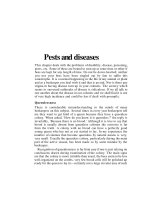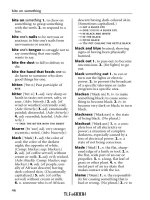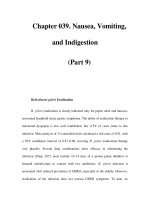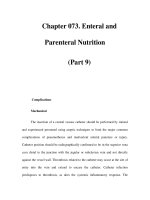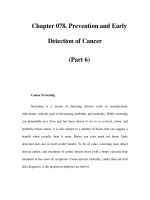Candida infections detection and epidemiology - part 9 pps
Bạn đang xem bản rút gọn của tài liệu. Xem và tải ngay bản đầy đủ của tài liệu tại đây (261.03 KB, 15 trang )
Discussion
Discussion
112
Despite the fact that the yeast Candida is the number 4 cause of bloodstream infections in
the United States and ranks number 8 in Europe
9,16
, adequate detection methods are lacking.
Furthermore, relatively little is known about the epidemiology of Candida, including the main
Candida species, C. albicans. In both fields, knowledge has increased in the past decade due to
the rapid development and improvements of molecular biological techniques. This is
illustrated by the fact that a clinically relevant species, C. dubliniensis, was misidentified as C.
albicans until the discovery of the genetic differences between the species led to its recognition
in 1995
33
. Our aim was to improve the detection of Candida infections and to study the
epidemiology of these infections in Europe. Most research was performed by using two
relatively new molecular biological tools: Nucleic Acid Sequence-Based Amplification
(NASBA™)
6
and Amplified Fragment Length Polymorphism analysis (AFLP™)
35
.
D
ETECTION OF CANDIDA INFECTIONS
The current routine detection method for Candida infections, automated blood culture, is
inadequate. In many cases the blood cultures remain negative, even when the patient suffers
from candidaemia
20
. It is hypothesized that at least in some cases this is a technical problem of
the monitoring system. Shigei et al. and Tinghitella and Lamagdeleine have shown, that some
automated blood culture instruments may fail to detect yeasts in spite of good growth of the
organisms in the culture bottles, as was demonstrated by confluent growth after
subculturing
31,34
. Other authors, however, claim that all important pathogens (including yeasts)
are detected within the standard incubation time, without the need for terminal
subculture
18,26,37
. In Chapter 1 we examined whether terminal subculture of negative blood
culture bottles improves the detection rate for patients with candidaemia
3
. For three of the ten
patients studied, subculturing resulted in extra information. For one patient, this information
was clinically relevant: yeast was detected up to 7 days after the last positive blood culture.
Since the patient was treated with antifungal agents, blood culturing alone would have
suggested that the infection was adequately treated. Therefore, we believe that routine terminal
subculturing of negative blood cultures from patients with suspected candidaemia and patients
under treatment for candidaemia might be valuable.
Chapters 2, 3 and 4 describe the development of a NASBA assay for the detection of
Candida species in blood and blood cultures. Preliminary experiments on clinical material
showed that it is possible to detect the yeast in blood and serum samples, without the prior
need for culture (Chapter 2)
36
. However, since only a very small number of Candida cells may
be present in the blood during candidaemia
25
, we also investigated whether the NASBA assay
can be used to improve the detection rate after blood culturing, by testing samples from blood
culture bottles which remained negative in the blood culture system (Chapter 3). Furthermore,
we examined whether a short pre-culture step of two days could improve the detection rate
(Chapter 4). The results were encouraging in both cases. When the NASBA assay was used to
detect Candida in blood cultures which were negative in the BacT/Alert monitoring system,
the number of positive blood cultures increased with 62% (from 21% to 34%)
4
. Furthermore,
we demonstrated that a substantial increase in detection rate can already be obtained with a 2
day pre-culture step: 80% of all samples positive in the NASBA assay in Chapter 4 were pre-
Discussion
113
cultured for two days. In the same study, Candida RNA was detected in the blood of a patient,
whereas no yeast was detected by the automated blood culturing system. In another patient the
NASBA assay detected the infection two days earlier than the blood culture system
5
. Although
the number of patients included in these studies was limited, the results indicate that improved
detection of Candida infections (detection rate as well as speed) is possible. Improved
detection will lead to a reduced morbidity and mortality.
One of the main advantages of the NASBA technology is also its disadvantage. The high
sensitivity compared to other amplification methods makes it more prone to problems with
contaminations. This was illustrated in Chapter 5, where an attempt to replace our in-house
NASBA amplification protocol by a commercial kit failed due to contaminated kit
components. Based on a literature review (Chapter 6) and our own experiences it was
concluded that in many cases problems with contaminations occur because people are unaware
of the impact which their undertakings have on the environment. Even non-molecular
biologists may be working with large amounts of DNA and form an unexpected risk of
contaminations, e.g. protein chemists who study recombinant proteins by using plasmids as
expression systems. Therefore, all researchers using the same laboratory space and equipment
should conduct themselves to stringent precautions, without any exceptions. The problem
described in Chapter 5 originated from the manufacturer. Although it is difficult to take
stringent measures for contamination control in a large-scale production process, the
increasing request for standardized nucleic acid amplification assays obligates diagnostic
companies to reevaluate their procedures.
The NASBA assay is able to detect most medically important Candida species. However,
it is unfeasible to implement probes for all the different species in the assay. It is highly likely
that uncommon species are encountered, which cannot be identified with the NASBA assay.
Therefore, the availability of an identification tool which is universally applicable is desired.
This is especially important considering the fact that less common Candida species are
emerging and a new species (C. dubliniensis) was recognized only recently
17,32
. In Chapter 7
of this thesis we show that AFLP is an excellent method for the identification of Candida
species. The different species show very distinct clusters, and by using this technique we
discovered that 6% of our (phenotypically identified) collection of clinical Candida isolates
was misidentified. The potential of storing AFLP patterns in general accessible databases will
greatly enhance the chances of a correct identification.
E
PIDEMIOLOGY OF CANDIDA INFECTIONS
The second objective of this thesis was to study the epidemiology of Candida albicans
infections in Europe. Some strains of the same species may be associated with a specific type
of disease or may be restricted to a certain geographic region. It is important to recognize such
correlations, and to identify the underlying mechanisms. Although Candida albicans is capable
of sexual reproduction and recombination occurs to some extent, the yeast reproduces mainly
clonally
11,12,14,19
. Therefore, all genes are associated and research on the epidemiology of
clinically important traits such as the expression of virulence factors may lead to the
identification of genetic markers for these traits. This may result in improved therapeutic
regimens.
Discussion
114
In Chapter 8 we investigated whether the expression of two putative virulence factors of C.
albicans, (phospho)lipases and proteinases
8,10
, are associated with a certain type of infection or
with the geographic origin of the isolates. It appeared that compared to infections of blood, the
urinary tract or wound/skin/soft tissue, a relatively high number of isolates which were
involved in pneumonia produced (phospho)lipases. Also, a significantly higher number of
these isolates were among the higher producers of this enzyme. A similar trend was observed
for the production of proteinases: all isolates obtained from pneumonia were positive in the
proteinase assay, and 96% of these isolates were high producers. These results suggest that
isolates involved in pneumonia are more virulent than isolates obtained from the other types of
infection that were studied. It is hypothesized that selection for more virulent isolates in
debilitated individuals occurs in HIV-positive patients
7,7,23
. Also, oral C. albicans isolates from
healthy volunteers show a relatively low phospholipase activity, whereas clinical isolates from
the oral cavities of patients suffering from oral candidosis produce relatively high amounts of
this enzyme
15,27
. It will be interesting to study whether the enhanced (phospho)lipase and
proteinase production in pneumonia-derived isolates is caused by a positive selection of more
virulent isolates, and to elucidate the mechanisms behind such a selection.
Another interesting epidemiological finding is described in Chapter 9. By using AFLP as a
fingerprinting method, we typed a large collection of European C. albicans isolates. It was
discovered, that isolates from Portugal and Spain all belonged to the same AFLP cluster
(cluster 1), whereas isolates from the United Kingdom and all but one isolate from Germany
belonged to another cluster (cluster 2). Isolates from France, Italy, Switzerland, and Turkey
were represented in both clusters. These results indicate the presence of an Iberian and a
Northern European clone. Geographical specificities of certain C. albicans strains have been
demonstrated before for isolates from South-Africa, Singapore, and the North-Eastern United
States
2,24,29
. To our knowledge, this is the first time that such specificities have been
demonstrated for Europe.
Although AFLP has been established as a typing method for several microorganisms
including the yeast Saccharomyces cerevisiae
1,28
, we will need to compare AFLP with another
fingerprinting method on the same group of isolates to validate the feasibility of this technique
as a typing method for C. albicans. The difficulty, however, is that no other typing method has
been accepted as the golden standard for typing of Candida.
It can be concluded that our first objective, improved detection of Candida infections, was
feasible. Although the implementation of the NASBA assay in a routine laboratory needs
further efforts, we have demonstrated that this assay can lead to a more rapid detection as well
as increased detection rates. The second objective, to study the epidemiology of C. albicans
infections in Europe, resulted in two interesting discoveries: C. albicans isolates involved in
pneumonia seem to be more virulent than isolates involved in other types of infection, and
European C. albicans isolates can be distinguished in an Iberian and a Northern European
AFLP-type, which are mingled in Central European countries. These last two findings can be
the onset of extensive epidemiological studies.
Discussion
115
R
EFERENCES
1. Azumi, M. and N. Goto-Yamamoto. 2001. AFLP analysis of type strains and laboratory and industrial
strains of Saccharomyces sensu stricto and its application to phenetic clustering. Yeast 18: 1145-1154
2. Blignaut, E., C. Pujol, S. Lockhart, S. Joly, and D.R. Soll. 2002. Ca3 Fingerprinting of Candida albicans
Isolates from Human Immunodeficiency Virus-Positive and Healthy Individuals Reveals a New Clade in
South Africa. J. Clin. Microbiol. 40: 826-836
3. Borst, A., M. Leverstein-Van Hall, J. Verhoef, and A. Fluit. 2000. Value of terminal subculture of
automated blood cultures in patients with candidaemia. Eur. J. Clin. Microbiol. Infect. Dis. 19: 803-805
4. Borst, A., M.A. Leverstein-Van Hall, J. Verhoef, and A.C. Fluit. 2001. Detection of Candida spp. in
blood cultures using nucleic acid sequence-based amplification (NASBA). Diagn. Microbiol. Infect. Dis. 39:
155-160
5. Borst, A., J. Verhoef, E. Boel, and A.C. Fluit. 2002. Clinical evaluation of a NASBA-based assay for
detection of Candida spp. in blood and blood cultures. Clin. Lab. (In press)
6. Compton, J. 1991. Nucleic acid sequence-based amplification. Nature 350: 91-92
7. De Bernardis, F., P. Chiani, M. Ciccozzi, G. Pellegrini, T. Ceddia, G. D'Offizzi, I. Quinti, P.A.
Sullivan, and A. Cassone. 1996. Elevated aspartic proteinase secretion and experimental pathogenicity of
Candida albicans isolates from oral cavities of subjects infected with human immunodeficiency virus. Infect.
Immun. 64: 466-471
8. De Bernardis, F., P.A. Sullivan, and A. Cassone. 2001. Aspartyl proteinases of Candida albicans and their
role in pathogenicity. Med. Mycol. 39: 303-313
9. Fluit, A.C., M.E. Jones, F.J. Schmitz, J. Acar, R. Gupta, and J. Verhoef. 2000. Antimicrobial
susceptibility and frequency of occurrence of clinical blood isolates in Europe from the SENTRY
antimicrobial surveillance program, 1997 and 1998. Clin. Infect. Dis. 30: 454-460
10. Ghannoum, M.A. 2000. Potential role of phospholipases in virulence and fungal pathogenesis. Clin.
Microbiol. Rev. 13: 122-43, table
11. Gow, N.A., A.J. Brown, and F.C. Odds. 2000. Candida's arranged marriage. Science 289: 256-257
12. Graser, Y., M. Volovsek, J. Arrington, G. Schonian, W. Presber, T.G. Mitchell, and R. Vilgalys. 1996.
Molecular markers reveal that population structure of the human pathogen Candida albicans exhibits both
clonality and recombination. Proc. Natl. Acad. Sci. U. S. A 93: 12473-12477
13. Gumbo, T., C.M. Isada, G. Hall, M.T. Karafa, and S.M. Gordon. 1999. Candida glabrata Fungemia.
Clinical features of 139 patients. Medicine (Baltimore) 78: 220-227
14. Hull, C.M., R.M. Raisner, and A.D. Johnson. 2000. Evidence for mating of the "asexual" yeast Candida
albicans in a mammalian host. Science 289: 307-310
15. Ibrahim, A.S., F. Mirbod, S.G. Filler, Y. Banno, G.T. Cole, Y. Kitajima, J.E. Edwards, Jr., Y. Nozawa,
and M.A. Ghannoum. 1995. Evidence implicating phospholipase as a virulence factor of Candida albicans.
Infect. Immun. 63: 1993-1998
16. Jarvis, W.R. 1995. Epidemiology of nosocomial fungal infections, with emphasis on Candida species. Clin.
Infect. Dis. 20: 1526-1530
17. Kao, A.S., M.E. Brandt, W.R. Pruitt, L.A. Conn, B.A. Perkins, D.S. Stephens, W.S. Baughman, A.L.
Reingold, G.A. Rothrock, M.A. Pfaller, R.W. Pinner, and R.A. Hajjeh. 1999. The epidemiology of
candidemia in two United States cities: results of a population-based active surveillance. Clin. Infect. Dis. 29:
1164-1170
18. Kennedy, G.T., J.G. Barr, and C. Goldsmith. 1995. Detection of bacteraemia by the continuously
Discussion
116
monitoring BacT/Alert system. J. Clin. Pathol. 48: 912-914
19. Magee, B.B. and P.T. Magee. 2000. Induction of mating in Candida albicans by construction of MTLa and
MTLalpha strains. Science 289: 310-313
20. Maksymiuk, A.W., S. Thongprasert, R. Hopfer, M. Luna, V. Fainstein, and G.P. Bodey. 1984. Systemic
candidiasis in cancer patients. Am. J. Med. 77: 20-27
21. Moran, G.P., D. Sanglard, S.M. Donnelly, D.B. Shanley, D.J. Sullivan, and D.C. Coleman. 1998.
Identification and expression of multidrug transporters responsible for fluconazole resistance in Candida
dubliniensis. Antimicrob. Agents Chemother. 42: 1819-1830
22. Moran, G.P., D.J. Sullivan, M.C. Henman, C.E. McCreary, B.J. Harrington, D.B. Shanley, and D.C.
Coleman. 1997. Antifungal drug susceptibilities of oral Candida dubliniensis isolates from human
immunodeficiency virus (HIV)-infected and non-HIV-infected subjects and generation of stable fluconazole-
resistant derivatives in vitro. Antimicrob. Agents Chemother. 41: 617-623
23. Ollert, M.W., C. Wende, M. Gorlich, C.G. McMullan-Vogel, M. Borg-von Zepelin, C.W. Vogel, and
H.C. Korting. 1995. Increased expression of Candida albicans secretory proteinase, a putative virulence
factor, in isolates from human immunodeficiency virus-positive patients. J. Clin. Microbiol. 33: 2543-2549
24. Pfaller, M.A., S.R. Lockhart, C. Pujol, J.A. Swails-Wenger, S.A. Messer, M.B. Edmond, R.N. Jones,
R.P. Wenzel, and D.R. Soll. 1998. Hospital specificity, region specificity, and fluconazole resistance of
Candida albicans bloodstream isolates. J. Clin. Microbiol. 36: 1518-1529
25. Rand, K.H., H. Houck, and M. Wolff. 1994. Detection of candidemia by polymerase chain reaction. Mol.
Cell Probes. 8: 215-221
26. Reisner, B.S. and G.L. Woods. 1999. Times to detection of bacteria and yeasts in BACTEC 9240 blood
culture bottles. J. Clin. Microbiol. 37: 2024-2026
27. Samaranayake, L.P., J.M. Raeside, and T.W. MacFarlane. 1984. Factors affecting the phospholipase
activity of Candida species in vitro. Sabouraudia. 22: 201-207
28. Savelkoul, P.H., H.J. Aarts, J. de Haas, L. Dijkshoorn, B. Duim, M. Otsen, J.L. Rademaker, L.
Schouls, and J.A. Lenstra. 1999. Amplified-fragment length polymorphism analysis: the state of an art. J.
Clin. Microbiol. 37: 3083-3091
29. Schmid, J., S. Herd, P.R. Hunter, R.D. Cannon, M.S. Yasin, S. Samad, M. Carr, D. Parr, W.
McKinney, M. Schousboe, B. Harris, R. Ikram, M. Harris, A. Restrepo, G. Hoyos, and K.P. Singh.
1999. Evidence for a general-purpose genotype in Candida albicans, highly prevalent in multiple
geographical regions, patient types and types of infection. Microbiology 145 ( Pt 9): 2405-2413
30. Schmid, J., P.R. Hunter, G.C. White, A.K. Nand, and R.D. Cannon. 1995. Physiological traits associated
with success of Candida albicans strains as commensal colonizers and pathogens. J. Clin. Microbiol. 33:
2920-2926
31. Shigei, J.T., J.A. Shimabukuro, M.T. Pezzlo, L.M. de la Maza, and E.M. Peterson. 1995. Value of
terminal subcultures for blood cultures monitored by BACTEC 9240. J. Clin. Microbiol. 33: 1385-1388
32. Sullivan, D. and D. Coleman. 1998. Candida dubliniensis: characteristics and identification. J. Clin.
Microbiol. 36: 329-334
33. Sullivan, D.J., T.J. Westerneng, K.A. Haynes, D.E. Bennett, and D.C. Coleman. 1995. Candida
dubliniensis sp. nov.: phenotypic and molecular characterization of a novel species associated with oral
candidosis in HIV-infected individuals. Microbiology 141 ( Pt 7): 1507-1521
34. Tinghitella, T.J. and M.D. Lamagdeleine. 1995. Assessment of Difco ESP 384 blood culture system by
terminal subcultures: failure to detect Cryptococcus neoformans in clinical specimens. J. Clin. Microbiol. 33:
3031-3033
Discussion
117
35. Vos, P., R. Hogers, M. Bleeker, M. Reijans, T. Van de Lee, M. Hornes, A. Frijters, J. Pot, J. Peleman,
M. Kuiper, and M. Zabeau. 1995. AFLP: a new technique for DNA fingerprinting. Nucleic Acids Res. 23:
4407-4414
36. Widjojoatmodjo, M.N., A. Borst, R.A. Schukkink, A.T. Box, N.M. Tacken, B. Van Gemen, J. Verhoef,
B. Top, and A.C. Fluit. 1999. Nucleic acid sequence-based amplification (NASBA) detection of medically
important Candida species. J. Microbiol. Methods 38: 81-90
37. Ziegler, R., I. Johnscher, P. Martus, D. Lenhardt, and H.M. Just. 1998. Controlled clinical laboratory
comparison of two supplemented aerobic and anaerobic media used in automated blood culture systems to
detect bloodstream infections. J. Clin. Microbiol. 36: 657-661
Nederlandse samenvatting
Samenvatting
120
Candida is een opportunistische gistsoort die ernstige infecties kan veroorzaken in patiënten
met een verminderde afweer. Candida albicans komt het meest voor, maar andere Candida
soorten zoals C. glabrata en C. krusei worden steeds vaker geïsoleerd. Risicogroepen voor
Candida infecties zijn neutropene kankerpatiënten, beenmerg- en orgaantransplantatie-
patiënten, AIDS-patiënten, diabetici, patiënten die worden behandeld met breedspectrum
antibiotica en patiënten die parenterale voeding krijgen. Van alle micro-organismen die
bloedbaan infecties veroorzaken komt Candida op de 4
e
plaats in Noord-Amerika, en op de 8
e
plaats in Europa. Toch is de standaard detectiemethode voor deze infecties, geautomatiseerde
bloedkweek, niet toereikend. Veel infecties blijven ongedetecteerd of worden pas na meerdere
dagen aangetoond. Daarna duurt het nog één of soms meerdere dagen voordat duidelijk is om
welke soort Candida het gaat. Sommige onderzoekers zijn van mening dat de detectie
verbeterd kan worden door de negatieve bloedkweken af te enten. Uit het onderzoek
beschreven in hoofdstuk 1, waarin negatieve bloedkweken van patiënten met candidaemie
werden afgeënt, blijkt dat dit afenten kan leiden tot extra (klinisch relevante) informatie: na
afenten werden positieve bloedkweken gevonden op een moment dat de patiënt werd
behandeld met antimycotica. Bloedkweken zonder afenten zou hebben gesuggereerd dat de
behandeling aansloeg. Het is daarom aan te bevelen om negatieve bloedkweken van patiënten
die verdacht worden van candidaemie of patiënten die behandeld worden voor deze infectie af
te enten voor verder onderzoek.
Het is belangrijk om te weten welke Candida soort de veroorzaker is van een infectie. C.
krusei is bijvoorbeeld resistent tegen één van de meest gebruikte antimycotica, fluconazol, en
het is bekend dat C. glabrata deze resistentie snel kan ontwikkelen. Om zo snel mogelijk met
de juiste behandeling te kunnen starten is het dus belangrijk om een detectiemethode te hebben
die niet alleen snel is, maar ook tot op soortniveau kan aangeven welke gist de infectie
veroorzaakt.
Door hun snelheid en gevoeligheid zijn nucleïnezuur-amplificatiemethoden belangrijke
kandidaten voor het verbeteren van de diagnostiek van infecties. De meest gebruikte techniek
is de Polymerase Chain Reaction (PCR), waarin specifieke stukjes DNA worden vermeerderd
tot een aantoonbaar niveau. In 1991 werd echter een nieuwe techniek beschreven die een aantal
voordelen heeft boven PCR. Deze techniek, Nucleic Acid Sequence-Based Amplification
(NASBA), is gebaseerd op het vermeerderen van specifieke stukjes RNA in plaats van DNA.
In tegenstelling tot PCR vindt dit proces plaats bij een constante temperatuur waardoor er geen
dure warmtewisselaar hoeft worden aangeschaft. Daarnaast wordt er per reactie veel meer
product gevormd dan bij PCR, waardoor de techniek gevoeliger is.
De hoodfstukken 2, 3 en 4 beschrijven de ontwikkeling van een NASBA assay voor het
aantonen van Candida RNA in bloed en bloedkweken. Uit hoofdstuk 2 blijkt dat het mogelijk
is om de gist direct in bloed aan te tonen. Omdat er bij candidaemie echter vaak sprake is van
zeer kleine aantallen gistcellen in het bloed, is er tevens gekeken naar de mogelijkheid om de
detectie van bloedkweken te verbeteren door met NASBA gist RNA aan te tonen in negatieve
bloedkweken (hoofdstuk 3). Daarnaast is in hoofdstuk 4 onderzocht of een korte voorkweek
stap van twee dagen de detectie verbeterde. In beide gevallen waren de resultaten
bemoedigend. Door de NASBA assay te gebruiken voor het aantonen van gist RNA in
bloedkweken die negatief bleven in de geautomatiseerde monitor werden 62% meer positieve
kweken gevonden (een stijging van 21% naar 34%). Daarnaast verbeterde de detectie
Samenvatting
121
substantieel na een korte voorkweek stap: 80% van de monsters die positief waren in de
NASBA assay in hoofdstuk 4 waren dat na twee dagen voorkweken. In dezelfde studie werd
Candida RNA aangetoond in het bloed van een patiënt waarvan alle bloedkweken negatief
waren gebleven. Bij een andere patiënt werd de infectie twee dagen eerder gedetecteerd in
vergelijking met de bloedkweken. Hoewel maar een klein aantal patiënten geïncludeerd was in
deze studies, blijkt uit de resultaten dat een verbetering van de detectie (zowel in aantal als in
snelheid) mogelijk is. Dit kan uiteindelijk leiden tot minder morbiditeit en mortaliteit bij de
patiënten.
Het belangrijkste voordeel van de NASBA is tevens ook een nadeel. Door de hoge
gevoeligheid vergeleken met andere technologiën is er ook een grotere kans op contaminaties.
Een duidelijk voorbeeld hiervan wordt beschreven in hoofdstuk 5, waar een poging om de
NASBA assay te standaardiseren met behulp van een commerciële kit mislukte doordat
bepaalde bestanddelen van de kit gecontamineerd waren met gist- of schimmel RNA. Naar
aanleiding van dit onderzoek en een literatuuronderzoek (beschreven in hoofdstuk 6) werd
geconcludeerd dat de meeste problemen met contaminaties zich voordoen omdat mensen zich
niet bewust zijn van het effect van hun handelen op hun omgeving. Ook niet-moleculair
biologen kunnen met grote hoeveelheden DNA werkzaam zijn en zo een onverwacht risico
vormen, bijvoorbeeld tijdens onderzoek naar recombinant-eiwitten die door middel van
plasmiden tot expressie gebracht worden. Het is daarom aan te raden dat alle onderzoekers die
dezelfde laboratoria en benodigdheden gebruiken zich aan dezelfde strenge
voorzorgsmaatregelen houden. Het in hoofdstuk 5 beschreven probleem stamde af van de
fabrikant. Hoewel het moeilijk is om strenge voorzorgsmaatregelen te nemen in een
grootschalig productieproces, zouden fabrikanten zich het belang van zulke maatregelen beter
moeten realiseren.
Met de in dit proefschrift ontwikkelde NASBA assay kunnen de belangrijkste Candida
soorten snel herkend worden. Het is echter hoogst aannemelijk dat er ook gistsoorten
gevonden zullen worden die met deze methode niet gespecificeerd kunnen worden. Het is
ondoenlijk om voor elke soort een extra probe aan de assay toe te voegen. Men zou daarom
naast de NASBA assay ook de beschikking moeten hebben over een universeel toepasbare
techniek, hoewel die doorgaans meer tijd in beslag nemen. In hoofdstuk 7 werd onderzocht of
zo'n universele techniek, Amplified Fragment Length Polymorphism analysis (AFLP) geschikt
is voor de identificatie van verschillende Candida soorten. De onderzochte soorten blijken
allemaal een uniek bandenpatroon te hebben, en met behulp van deze methode werd
aangetoond dat 6% van een grote collectie C. albicans isolaten in het verleden verkeerd
geïdentificeerd was. AFLP patronen zijn gemakkelijk op te slaan in algemeen toegankelijke
databestanden, hetgeen de kans op een correcte identificatie vergroot.
Naast het verbeteren van de detectie van Candida infecties wilden we in dit onderzoek ook
kijken naar de epidemiologie van C. albicans in Europa. Binnen een soort kunnen er bepaalde
stammen zijn de geassocieerd zijn met een bepaald type infectie of met een bepaalde
geografische locatie. Het aantonen van zulke relaties leidt tot een beter begrip van de
epidemiologie van een soort, en kan tevens een aanzet zijn tot bijvoorbeeld het vinden van
moleculaire markers voor belangrijke eigenschappen als virulentie. Uiteindelijk kan dit leiden
tot verbeterde therapeutische voorschriften. In hoofdstuk 8 werd onderzocht of er een relatie
bestaat tussen de productie van twee virulentiefactoren van C. albicans, (fosfo)lipasen en
Samenvatting
122
proteïnasen, en het type infectie of de geografische herkomst van de isolaten. In vergelijking
met isolaten afkomstig uit bloed, de urinewegen of wond/huid-infecties bleken significant
meer isolaten die betrokken waren bij pneumonieën (fosfo)lipasen te produceren. Tevens
produceerde een significant hoger aantal van deze isolaten grote hoeveelheden van dit enzym.
Vergelijkbare bevindingen werden gedaan voor proteïnasen: alle pneumonie-isolaten
produceerden dit enzym, en 96% van deze isolaten produceerden grote hoeveelheden. Deze
resultaten tonen aan dat isolaten betrokken bij pneumonie waarschijnlijk virulenter zijn dan
isolaten van andere typen infecties. Mogelijk heeft dit te maken met selectie van virulente
isolaten in patiënten met een verminderde afweer.
Een andere interessante bevinding werd gedaan on hoofdstuk 9. Een groot aantal Europese
C. albicans isolaten werd getypeerd. Hiervoor werd opnieuw gebruikt gemaakt van AFLP, een
techniek die naast identificatie van soorten ook geschikt is voor het aantonen van verschillen
binnen een soort. De Europese isolaten bleken onderverdeeld te kunnen worden in twee
clusters. Opvallend was, dat isolaten afkomstig uit Portugal en Spanje allen tot cluster 1
behoorden, terwijl isolaten uit het Verenigd Koninkrijk en Duitsland vrijwel allemaal tot
cluster 2 behoorden. Isolaten uit Frankrijk, Italië, Zwitserland en Turkije waren verdeeld over
de twee clusters. Deze resultaten impliceren het bestaan van een Iberische en een Noord-
Europese kloon.
In conclusie: in dit proefschrift is aangetoond dat een verbetering van de detectie van
Candida infecties mogelijk is, zowel in aantal als in snelheid. Daarnaast is ontdekt dat C.
albicans isolaten betrokken bij pneumonie virulenter zijn dan isolaten uit andere typen
infecties. Tevens lijkt het er op dat er binnen Europa sprake is van een Iberische- en een
Noord-Europese C. albicans-kloon. Deze laatste twee bevindingen kunnen het begin zijn van
een grootschalig epidemiologisch onderzoek.
